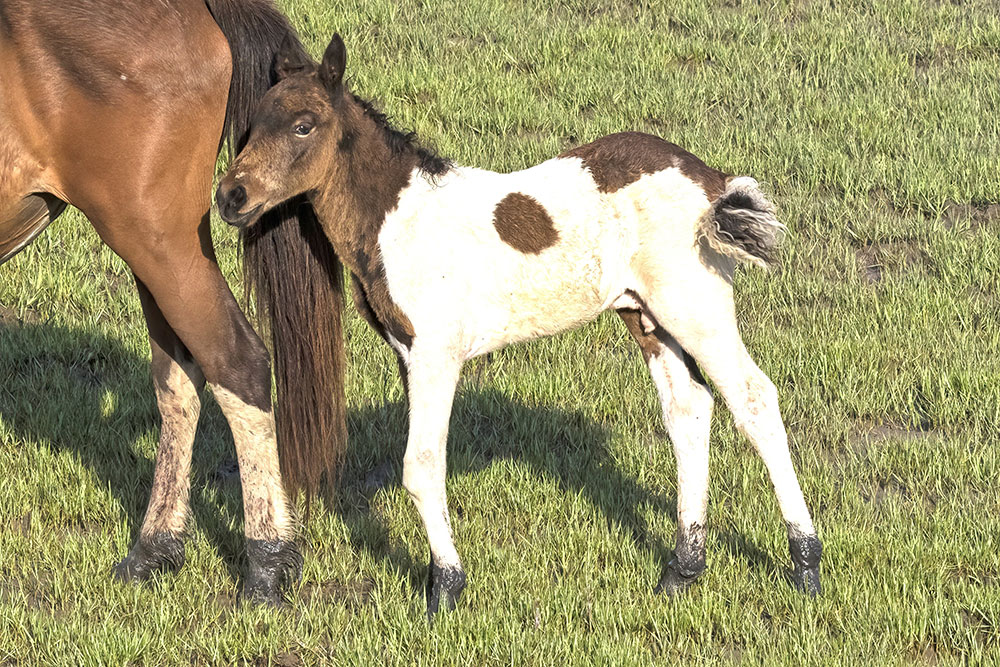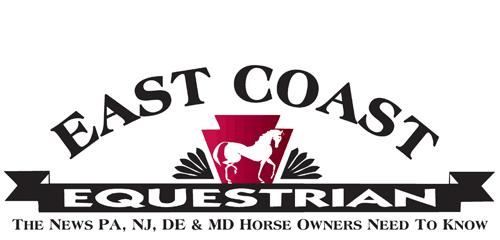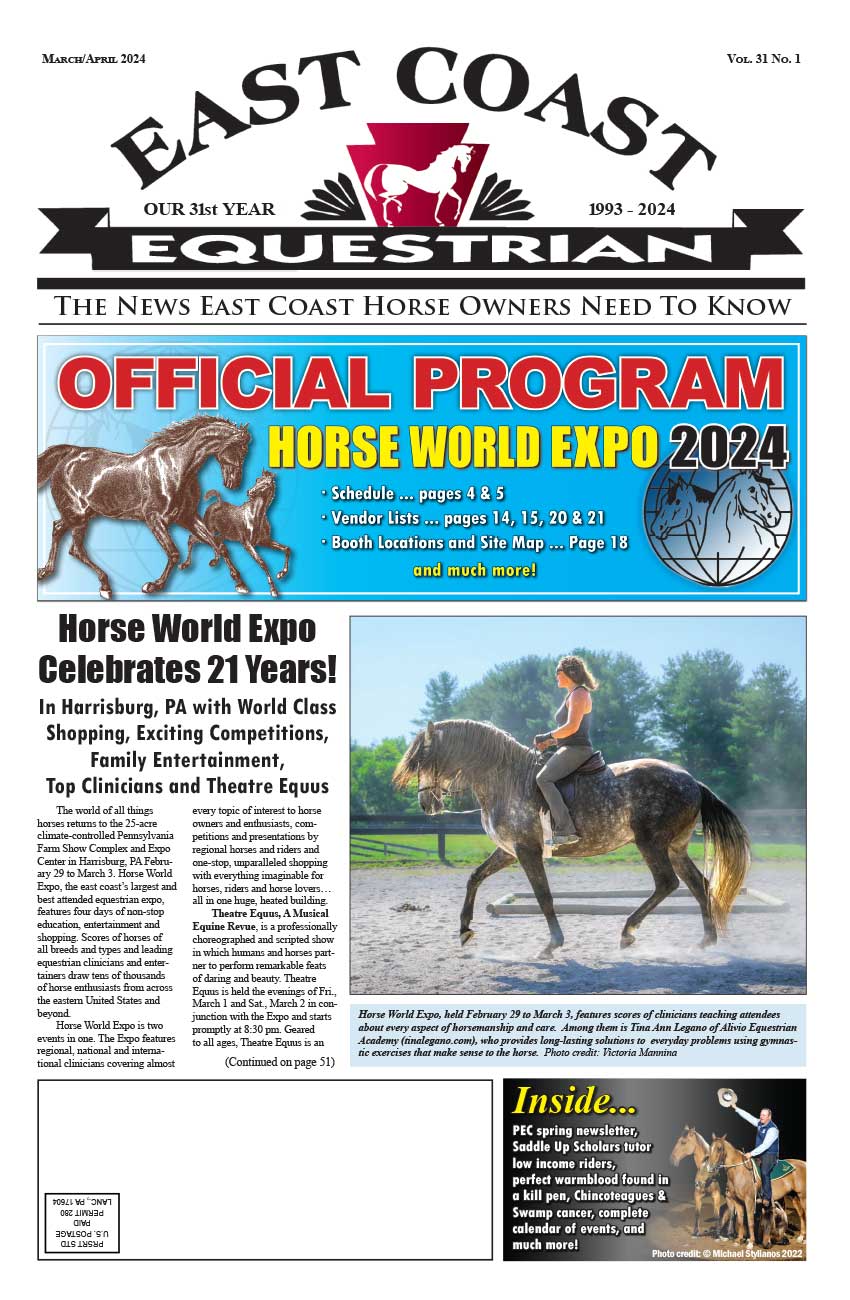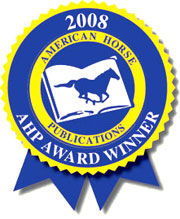 Buddy as a young foal. Photo Credit: DSC Photography
Buddy as a young foal. Photo Credit: DSC Photography
May 9, 2024 was an unseasonably hot spring day on the Chincoteague National Wildlife Refuge. This is the day that 25-year-old mare, ShyAnne gave birth to a beautiful dark bay pinto colt by the stallion Ajax. The colt was a little premature and his legs were not quite right. Slowly, he scrambled to his feet.
Darcy Cole said she remembers being worried about him right from the start. She’d just left saltwater cowboys, Billy Reed and Ayden Hunter, who were treating a mare named Waterbaby. Darcy had called them after she realized the mare was colicking.
“They saved her life that day,” Darcy said.
In the distance, she saw ShyAnne had a newborn foal. After the cowboys arrived for Waterbaby she hiked toward the older mare.
“I remember being worried about [the colt] from the start,” Darcy said. “Not only was it the most uncomfortable day of the entire year for heat, humidity and bugs, but the poor little guy had such a hard time standing up. My heart went out to him. We spent a lot of time watching to be sure he was okay.”
It didn’t take long to realize the colt’s front legs were not straight. Even though his walk was stilted and a little awkward, he kept up with the others in his band, even running when necessary. The fire company who owns the wild Chincoteague Ponies was alerted and saltwater cowboy, Hunter Leonard found the mare and colt shortly after, checking on him to see if he was able to navigate with the rest of the band.
“It’s not always easy to catch a wild foal,” said Tipson Myers of Hughesville, PA and owner of Stoney Creek Chincoteagues farm. She works with the firemen frequently to rehabilitate ponies on the mend.
“We know that Hunter tried to catch him several times, but he was actually running away from him,” she said.
It was foal season and best for all members of the herd to not stir things up. They decided to keep an eye on the colt but leave him out with his dam until the Pony Penning roundup in late July.
“This is not the first time this has happened in the herd or even with domestic horses,” said Tipson. She and her friend and equine vet, Allison Dotzel frequently take island ponies to the farm for treatment and rehabilitation.
Allison agreed.
“Yes, there can be limb deformities,” she said. “A lot of times they straighten out as the foal unfolds and begins to walk and move. Buddy did improve, but not a lot. When he came into the pen at the north roundup [veterinarian] Cara Rosenbaum was there and she saw that he was having some issues coming down the road, so they put him and [his dam] Shyanne in a trailer and brought them back to the carnival grounds.”
Allison, who worked with the vet team at Pony Penning, said Dr. Rosenbaum did some splinting and IV treatments. and the fire company decided this foal would not go through the sale. Instead, pony committee chairman, Mark Bowden approached Tipson to ask if she wanted to take him in.
“I asked if they were ready to retire ShyAnne, too,” Tipson recalled. “She was older, and we thought it would be good for her to be with him.”
So ShyAnne and the foal were loaded up in July and transported to Pennsylvania. The mare had produced many beautiful foals over the years and she deserved retirement. Tipson said being with his dam may have given him an advantage in healing. The foal was named Buddy.
Soon after he arrived, there was corrective shoeing using glue-on extensions.
“Our farrier helped with that,” Allison said. “After taking x-rays, I called up to Cornell and talked to their surgeon.”
Cornell University veterinarian Aimee Colbath suggested surgery.
“She said she thought, to straighten his legs as much as possible and give him as close to a normal life as possible, we should do surgery and use what is called a transphyseal screw,” Allison said. “A screw was placed in both of his knees across the growth plate to stop the growth of one side of the knee while the other side caught up.”
Placement of a transphyseal screw bridges the growth plate on the medial aspect of the limb and retards the rate of growth. This allows the outside of the radius to catch up and straighten the limb.
Surgery to place the screws took place at Cornell in early September with Dr. Colbath. Since the left leg was more severely out of line than the right leg, Allison said he had his right screw removed first. Two or three weeks later the left leg screw was removed, giving that leg a chance to catch up.
“He has never been in any kind of pain, even after surgery,” Tipson noted, “and he was only on limited pain meds for a few days after surgery.”
“As time goes on, the better he moves and the happier he seems,” Allison said. “The goal was to make his legs as straight as possible, and while his legs aren’t perfect, we were aware they would not be perfect when we were going into the surgery.”
Prior to surgery, Buddy’s surgeon had said, while no one has a crystal ball to know the future, the fact that he is smaller and lighter and not putting a lot of weight on his legs might play in his favor, and it did. Today, Buddy runs in the field with his friend, 2024 Chincoteague Pony foal, Edgar. Tipson said one day he even jumped a square bale in the aisle!
“We don’t really know his future prognosis,” Allison shared. “His legs aren’t normal, but the positive thing is that he is sound and happy at this point, and we hope that continues. His knees aren’t perfectly straight, but his carpal joints [ankles] are not perfectly straight either. This makes his legs as straight as possible, and his legs are as functional as possible.”
Allison said Cornell University surgeon, Aimee Colbath was great. A few other surgeons were pessimistic about trying the surgery because he would never be completely normal. She was on the same page as Tipson and Allison.
“We just wanted to make it so that he could have a functional life,” Allison said.
Tipson nodded in agreement. “A lot of Chincoteague Ponies are just pets. They are never ridden. That is how it will be for Buddy.”
“We know Buddy will not be rideable, and we would never have him be ridden or pull a cart after all he has been through,” Allison said. “But he will be happy here on the farm.”
Tipson agrees that Buddy has a forever home with her. His care now is no different than any other foal, but he is more agile and no longer has restricted activity.
“He goes outside now,” she said. “We do try to keep him on level ground, so he is not going up and down hills,” Tipson said, “but he will always have a home with me as a pet. We feel honored that the firemen him entrusted to us and allowed us to take ShyAnne. And she is doing great, too!”




